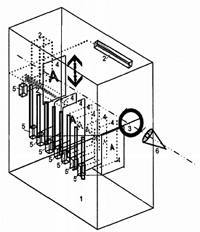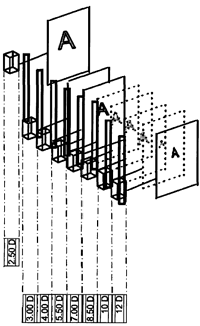ACCOMMODATION BOX FOR THE MODIFIED PUSH-UP METHOD
|
Description |
Scheme of the accommodation box: lighting system (2), eyepiece (3), optotype sheets (4), pushbuttons (5) eye (6)
This equipment allows the measurement of the amplitude of accommodation, with the variation of optotypes in size to maintain the angle that subtends to the corresponding distance.
The invention consists of a box containing the rest of the elements, the device has its own lighting system arranged on the sides to maintain uniformity on the sheets and provide sufficient contrast and intensity to maintain the interior with the standard lighting required for homework.
Inside the box a set of flat and parallel sheets is placed between them. In each sheet there is, at least, one letter or optotype printed on it and that varies in size between sheets. In each of these sheets of optotypes a push button is attached, which raises it up to the height of the eyepiece to be read. Each button has the equivalent value in power, or diopters O, inscribed to the distance that the plate is placed with respect to the eyepiece.
|
How does it work |
Accommodation is the physiological capacity or the state of focus of both eyes. It is measured using letters or ophthalmic lenses with the compensation of ametropia. In the optometric diagnosis of the subject's vision it is essential to know the value of the amplitude of accommodation.
In Optometry, two methods are used to evaluate the accommodation, the first using ophthalmic lenses and the second is the push-up method. This second method consists of bringing an optotype of letters of a fixed size towards the eye, until achieving the fuzziness maintained.
To perform the measurement by the push-up method, the patient's eye is placed in the eyepiece and the plates are changed, raising them one by one by means of the button and without obstructing the main line of sight, until the vision is compensated.
|
Advantages |
The technique of measuring the amplitude of accommodation by push-up has an important drawback, which wants to solve this invention, and which consists in a reduction of the visual acuity closely. This reduction is produced by the constancy in the size of the optotype, when approaching it according to the usual procedure.
The greatest advantage is the similar value of the amplitude of accommodation to that obtained with the minus lens procedure. This new device eliminates the errors of the test, such as overestimation or underestimation of the amplitude of accommodation. In addition, the increase of the optotype is avoided.
The measure of the accommodative amplitude by this procedure allows obtaining a value closer to that of the minus lens method.
|
Where has it been developed? |
The design, protected by national patent with previous examination since 2012, and its prototype, have been developed in the Faculty of Optics and Optometry.
|
Contact |
|
© Office for the Transfer of Research Results – UCM |
|
PDF Downloads |
|
Classification |
|
Responsible Researcher |
Ricardo Bernárdez Vilaboa: rbvoptom@ucm.es
Department: Optometry and Vision
Faculty: Optics and Optometry




